
Background
Harvey (previously The Business Pickle) is a business impact and sustainability advisory that supports leaders to learn and create meaningful action on social and environmental issues.
The advisory serves businesses that are in the early stages of developing their strategic approach on these matters, and provides support through landscape reviews and benchmarking; staff and stakeholder surveys and interviews; and strategic planning.
We recently engaged Harvey (previously The Business Pickle) to collaboratively develop Portable’s first environmental sustainability strategy. This case study outlines our recent collaboration, documents the process, and provides templates and tools for others to use.
The Challenge
Portable has always been committed to social justice and intentional about its impacts, demonstrated in its certification as a B Corporation.
However, the Portable team recognised the need to be more intentional about their environmental goals and understand the impact they were having as an organisation. Developing an environmental sustainability strategy became essential to fulfil Portable’s greater purpose for stakeholders and align with its social impact.
Andrew Apostola - Portable CEO:
“We realised we haven't been intentional enough about setting our environmental goals: understanding what impact we’re having as an organisation, and understanding what other organisations are doing outside and beyond Portable… Being intentional about putting together an environmental and sustainability policy is an essential part of us fulfilling a greater purpose for all of our stakeholders, and not leaving anything to chance.”
Why an environmental sustainability strategy?
As a business that has a small environmental footprint compared to many resource-intensive industries, is Portable’s action in this area really material? Why should a business that is already a certified B Corporation and creating positive social impacts invest time and resources into an environmental strategy?
- The climate crisis is urgent, and combined action cannot wait. It is a social problem as well as an environmental one. An environmental strategy helps Portable to understand the impacts - both positive and negative - of its organisation, products, and individual staff.
- Digital products - such as the websites and apps that Portable develops for clients - have an embedded carbon footprint that, depending on the hosting and website visitors, can be significant.
- As Portable openly shares its approach, learnings and progress on the environment, it is hoped that others in the industry will take note and take action themselves, amplifying the potential impact of this work.
- Sustainability includes different aspects across environmental and social dimensions. This environmental sustainability strategy is one piece of the puzzle, and is designed to sit alongside other strategies Portable develops, including social justice, a Reconciliation Action Plan, and the overall business strategy.
The 6 Step Approach
Working with The Business Pickle, Portable embarked on a comprehensive process to develop their environmental strategy. This was a collaborative process and involved the key steps which are detailed below.
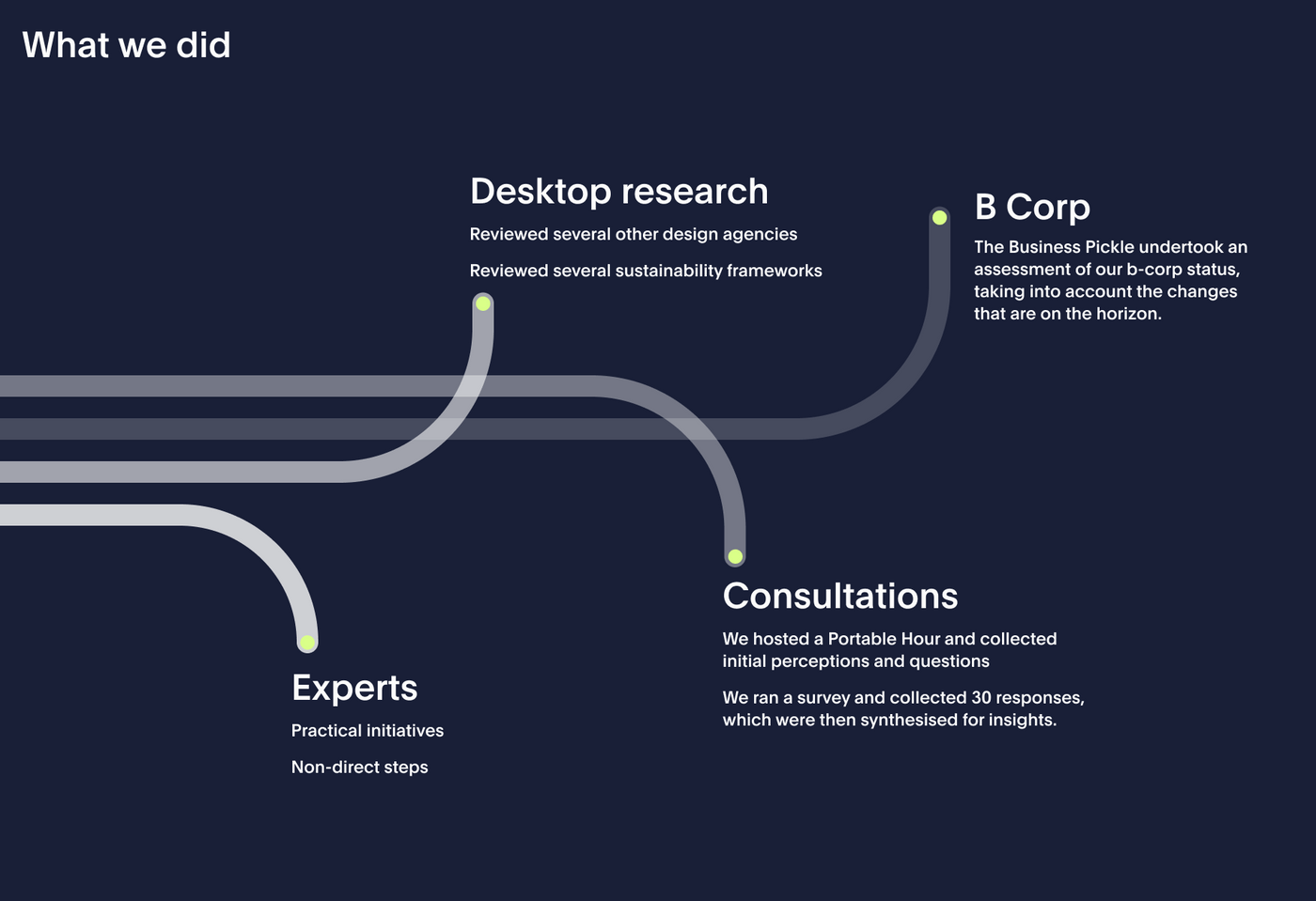
1. Identifying the need
Portable's strategic planning highlighted the absence of a clear environmental strategy. Recognising the importance of addressing this gap, the leadership team initiated the process and engaged The Business Pickle to support with research and strategic input.
2. Establishing a Working Group
To that end, Portable formed a working group to develop its environmental strategy. Portable's leaders selected individuals from their respective teams who demonstrated outcomes relevant to the sustainability and environmental strategy. These individuals were empowered to drive the process forward, work nimbly and quickly.
The working group members initially focused on the vision for this piece of work, their roles in bringing that vision to life and how they would work together. This phase involved open feedback exchanges to align on expectations, responsibilities, and the extent of pushing for change.
Andrew Apostola - Portable CEO:
“We first had to get through all the group-forming elements of understanding who we are, what our roles are, how we work, how we communicate… which is a great, tricky experience, but it’s natural.”
3. Engaging stakeholders
In order for the strategy to work in practice, it was important to enlist as many stakeholders as possible in the process, including a cross-section of Portable’s staff team.
This collaboration aimed to provide a safe space for feedback, experimentation, learning, and improvement as the strategy is rolled out.
Andrew Apostola - Portable CEO:
“A lot of the initiatives have come from the team itself because we engaged first to ask, “What is it that you want? What are the things that you think that you need or we need as an organisation?” Hopefully people will be able to see their fingerprint on some of the initiatives.
I think that the best approach is to be able to fully engage as many stakeholders on a journey of engagement as possible. It could be simple as listening, having a one-on-one interview, or a group working together to create and explore.
These are time intensive, but they bring people into the problem space. It means that they understand where you’re coming from and why you might be going in a direction. Ultimately you've got to engage people across the organisation - not just senior leadership - who are part of the concept development, listening, gathering feedback, policy development, testing that policy. That's how you build clarity and trust that the strategy that's being put forward is purpose fit for the organisation.”
4. Gathering insights
A number of key activities were undertaken to support the effective gathering of insights. These are detailed below.
4.1. Staff survey
The working group undertook various activities to gather insights and perspectives. They conducted a survey across the organisation to understand current views and potential directions.
Findings from the staff survey were then synthesised to draw out perspectives and ideas for initiatives within the strategy.
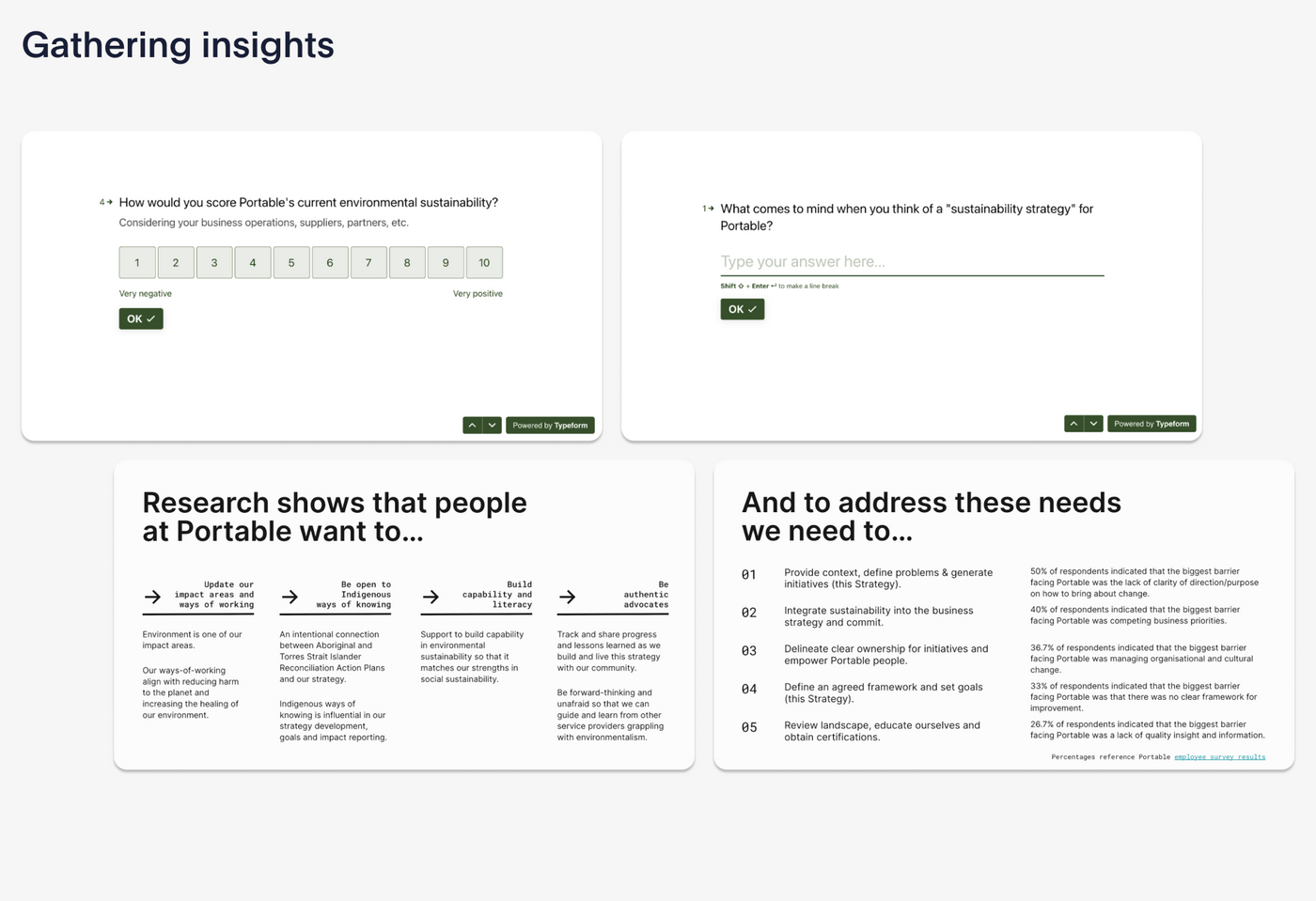
4.2. Industry interviews
Additionally, The Business Pickle and Portable conducted interviews with industry leaders to get insight into the current state of the sector and learn about different strategic approaches to supporting the environment.
Interviewees also gave their perspectives on what they would expect Portable to be doing in this space. Examples include:
- Leaders advocating for initiatives, and encouraging staff to lean in as much as they want or feel able to.
- Accounting for the carbon footprint of staff working remotely.
- Incentivising staff to switch to renewable energy providers.
- Certifying as carbon neutral.
- Partnering with SME Climate Hub.
- Providing useful tools to clients and other industry members.
- Making sustainability reporting publicly available.
- Conducting waste audits.
- Client procurement in areas of waste, energy, water, biodiversity.
4.3. B Corp active assessment review
Portable assessed their B Corp certification to identify areas of alignment and opportunities for improvement.
This evaluation helped inform the strategy development process and generated ideas for how Portable could take further steps to improve their environmental impacts in line with the existing B Corp framework.
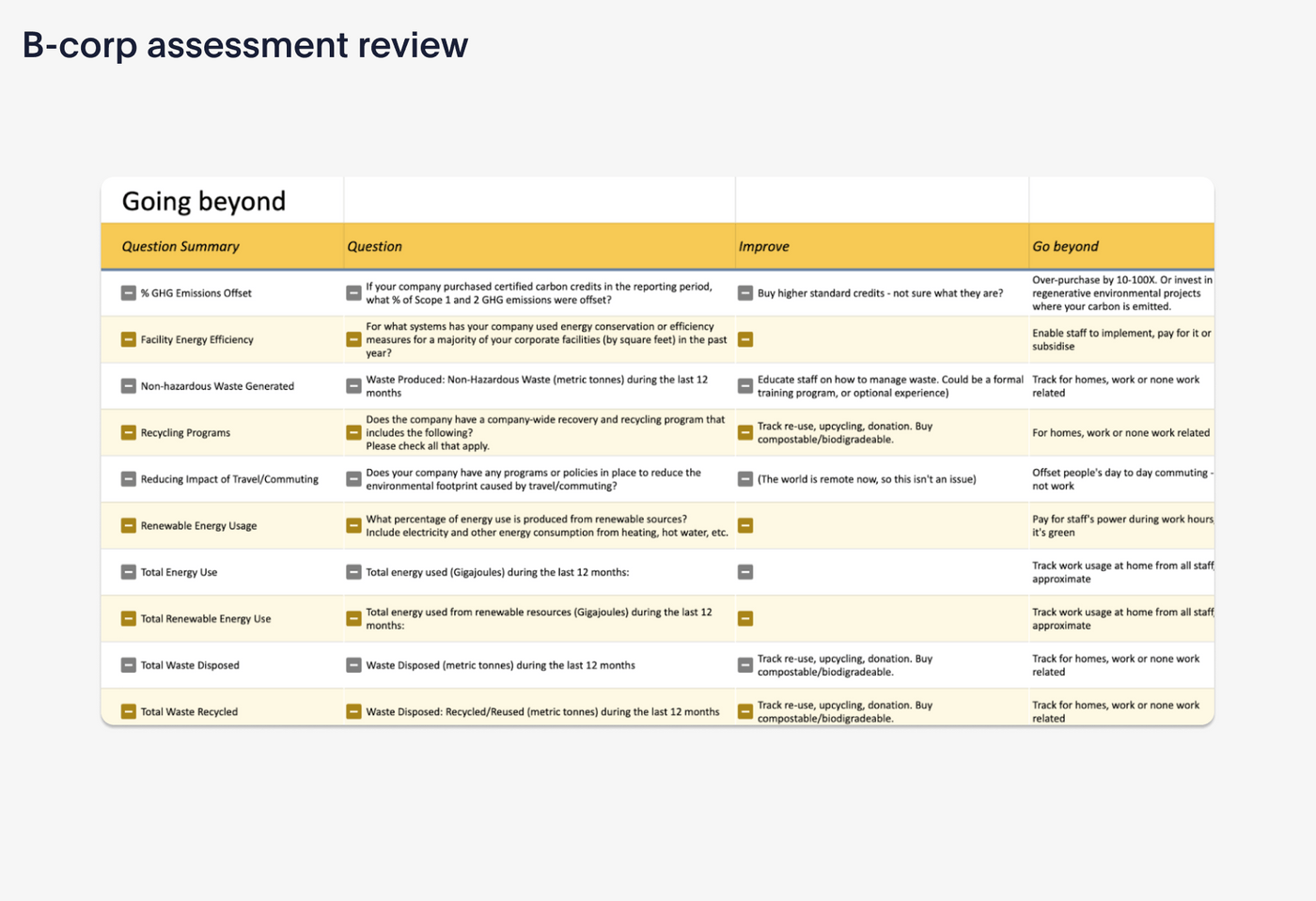
5. Developing a framework
Through desktop research and a workshop, Portable’s working group examined different sustainability frameworks, including the UN Sustainable Development Goals and frameworks adopted by local organisations. Based on their analysis and purpose-fit considerations, they developed a customised framework to guide Portable's sustainability and environmental initiatives.
The framework separates initiatives into three domains within the business:
- My work / way of living / as individuals
- Our work / area of impact / as project teams
- How we work / operations / as an organisation
This helps to clarify where the action is taking place and who is responsible for each initiative.
Get your workshop template for mapping initiatives across domains here!
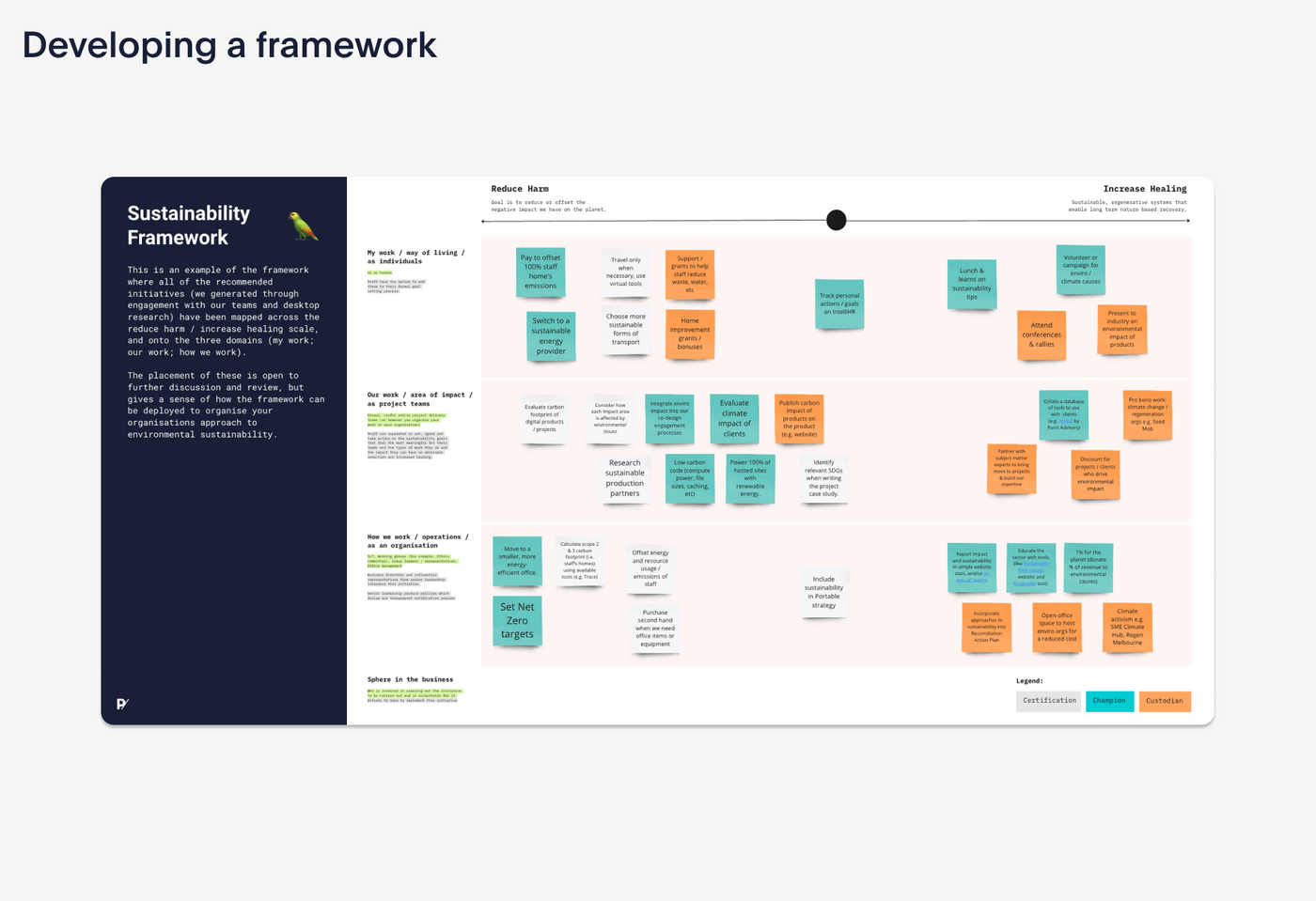
6. Testing and refinement
The working group tested the framework through workshops and discussions with the senior leadership team. They designed and assessed potential initiatives based on an impact spectrum, mapping these initiatives to determine implementation timing and priorities:
- Compliance — Meeting requirements.
- Certification — Meeting the B Corp standards on environment.
- Champions — High B Corp score on the environment, taking further steps to improve environmental impact.
- Custodians — Leading change in the industry.
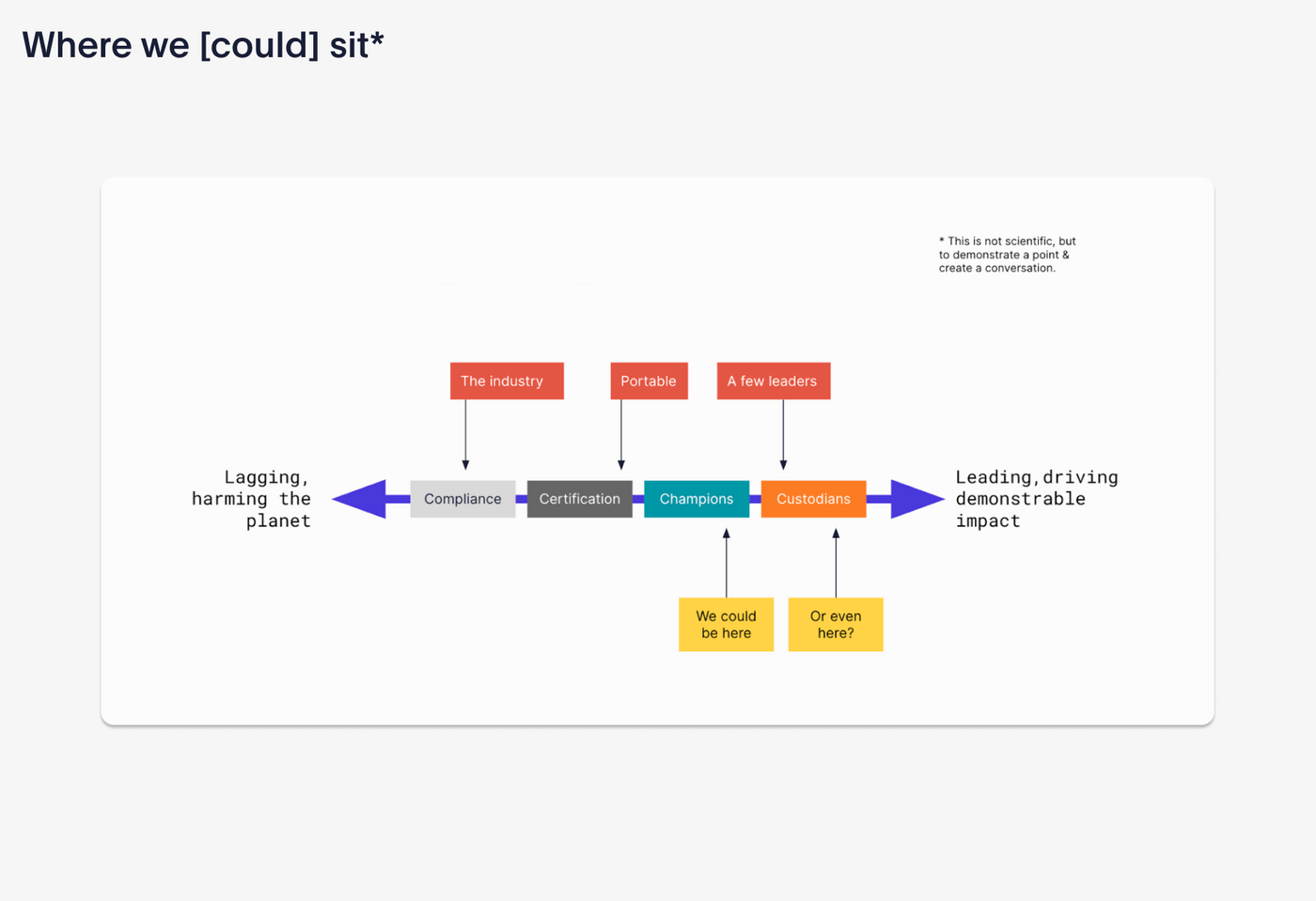
Stage terminology
This terminology was created to describe a sliding scale from lagging to leading and driving demonstrable impact.
- Compliance — Meeting legislative and regulatory requirements, so environmental strategy in place
- Certification — Meeting the standards of B Corp on the environment.
- Champion — High B Corp score on the environment, taking further steps to improve environmental impact.
- Custodian — Leading change in the industry.
The Strategy
Developed to be rolled out in four main phases with unique initiatives:
The timing of each initiative was decided according to how long it would take to complete, the costs and time involved, and the capacity of the team to implement.
Each initiative is mapped against the relevant domain (Organisation, Product/Team, Individual) and impact spectrum (Compliance, Certification, Champions, Custodians).
The initiatives range from short-term, low-cost, low-effort actions such as introducing a vegetarian food policy for office and event catering, through to actions that need to be rolled out over a longer period or require more investment, such as working towards a Net Zero 2025 target, and paying to offset 100% of staff’s home emissions.
The roadmap focuses on clear, tangible activities that are achievable for Portable to implement over the next three years, acknowledging the practical realities of operating the business.
Phase 1 (Jul-Dec ‘23)
Organisation
- Champion — Calculate scope 2 & 3 carbon footprint (i.e. staff's homes) using available tools (e.g. Trace).
- Champion — A vegetarian food policy.
- Custodian — Set Net Zero 2025 target (Aligned with Patagonia & head of Amazon) & public pledge.
Product/Team
- Certification — Identify relevant SDGs when writing the project case study.
- Champion — Evaluate carbon footprint of digital products / projects (product usage estimator here, project activities separate).
- Custodian — Environment as an impact area (waste, energy, water, biodiversity).
Individuals
- Certification — Lunch & learns on tips for staff.
- Champion — Time off to volunteer or campaign for enviro / climate causes (i.e. 2 days/year per staff member).
- Champion — Team track personal actions/goals in shared space to inspire and learn from each other.
Phase 2 (Jan-Jun ‘24)
Organisation
- Champion — Publicly publish learnings, policies, tools for peers and clients.
- Champion — Publish environmental impact report.
- Custodian — Climate activism e.g. SME Climate Hub, Regen Melbourne.
Product/Team
- Certification — Research sustainable delivery partners.
Individuals
- Champion — Pay to offset 100% of staff home's emissions.
- Champion — Incentivising staff to switch to renewable energy at home.
- Champion — Support staff with resources (education, courses, experts, etc) to help staff reduce waste, water, etc.
Phase 3 (Jul ‘24-Jun ‘25)
Organisation
- Certification — Certify 1% for the planet.
- Custodian — Incorporate approaches to sustainability into Reconciliation Action Plan.
- Custodian — Implement a environmental focused residency for individuals doing incredible work in the environment space.
Product/Team
- Champion — Define how each impact area is affected by environmental issues engagement processes.
- Champion — Integrate environmental impact into co-design.
- Champion — Collate a database of more sustainable tools to use with clients.
Individuals
- Champion — Team present to industry on environmental impact of products.
Phase 4 (Jul ‘25-Jun ‘26)
Organisation
- Custodian — Open office space to host environmental organisations for a reduced cost.
Product/Team
- Champion — Power 100% of hosted websites with renewable energy.
Individuals
- Custodian — Staff home major improvement grants / bonuses to reduce waste, improve home efficiency.
Each initiative in the strategy is linked to a key outcome:
- Accelerate sustainable ways of living — Support Portable staff to make changes towards a more environmentally responsible lifestyle.
- Encourage sector change — Encourage other organisations to level up their environmental approaches to drive wider systems change.
- Reduce waste & emissions — Use resources efficiently and choose lower impact resources (e.g. renewable energy) to reduce waste and emissions.
- Strategic alignment — Embed environmental sustainability in the broader Portable business strategy.
- Support sustainable innovations — Invest time and resources to amplify existing change-making organisations that protect ecosystems and drive innovations in sustainability.
- Verify & demonstrate impact — Validate and share Portable's environmental impact using evidence-based approaches.
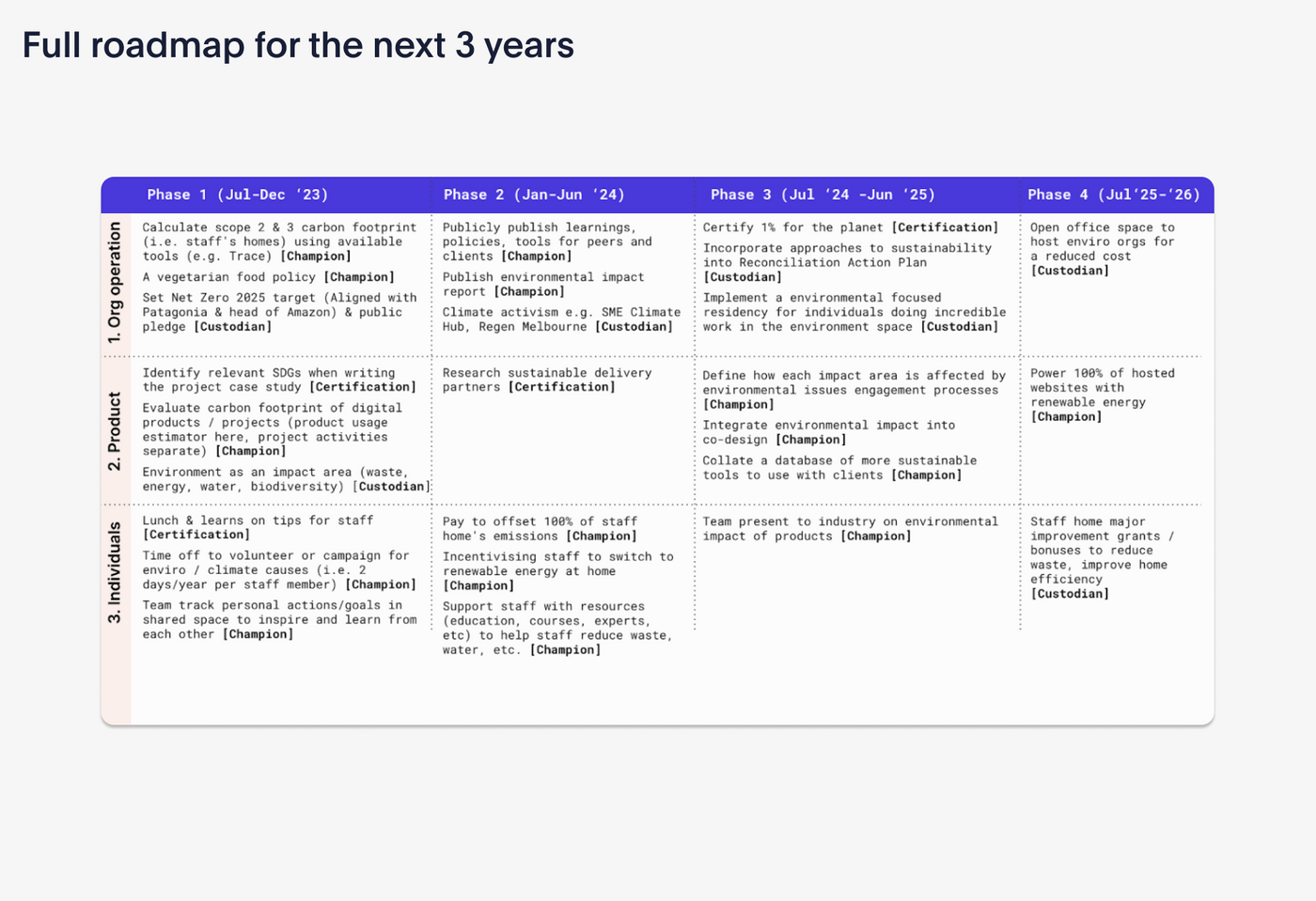
Reflections
Portable's journey to develop an environment strategy demonstrates the organisation’s commitment to aligning its broader strategy with environmental goals.
By splitting the strategy into three domains —individual, team, and organisation— the strategy emphasises accountability and involvement at all levels. This approach aims to foster a collective responsibility for driving environmental outcomes. It aims to shift the focus from a single person's responsibility to a shared effort.
The strategy development process allowed Portable to engage stakeholders, gather insights, and create a purpose-fit framework. It enabled the organisation to be intentional about their environmental goals, align their language with clients and staff, and mitigate potential misinterpretations.
By taking a comprehensive approach, Portable aimed to enhance their B Corp certification score, improve their environmental and sustainability impact, and facilitate change within the organisation and beyond.
Andrew Apostola - Portable CEO:
“When you've got a strategy where the organisation is responsible for the outcomes, it's very easy for it to fall to one person’s responsibility. What I like about [our approach] is that you’re signing up multiple people to be tracking as individuals, as teams, as a wider organisation to make a series of changes.”
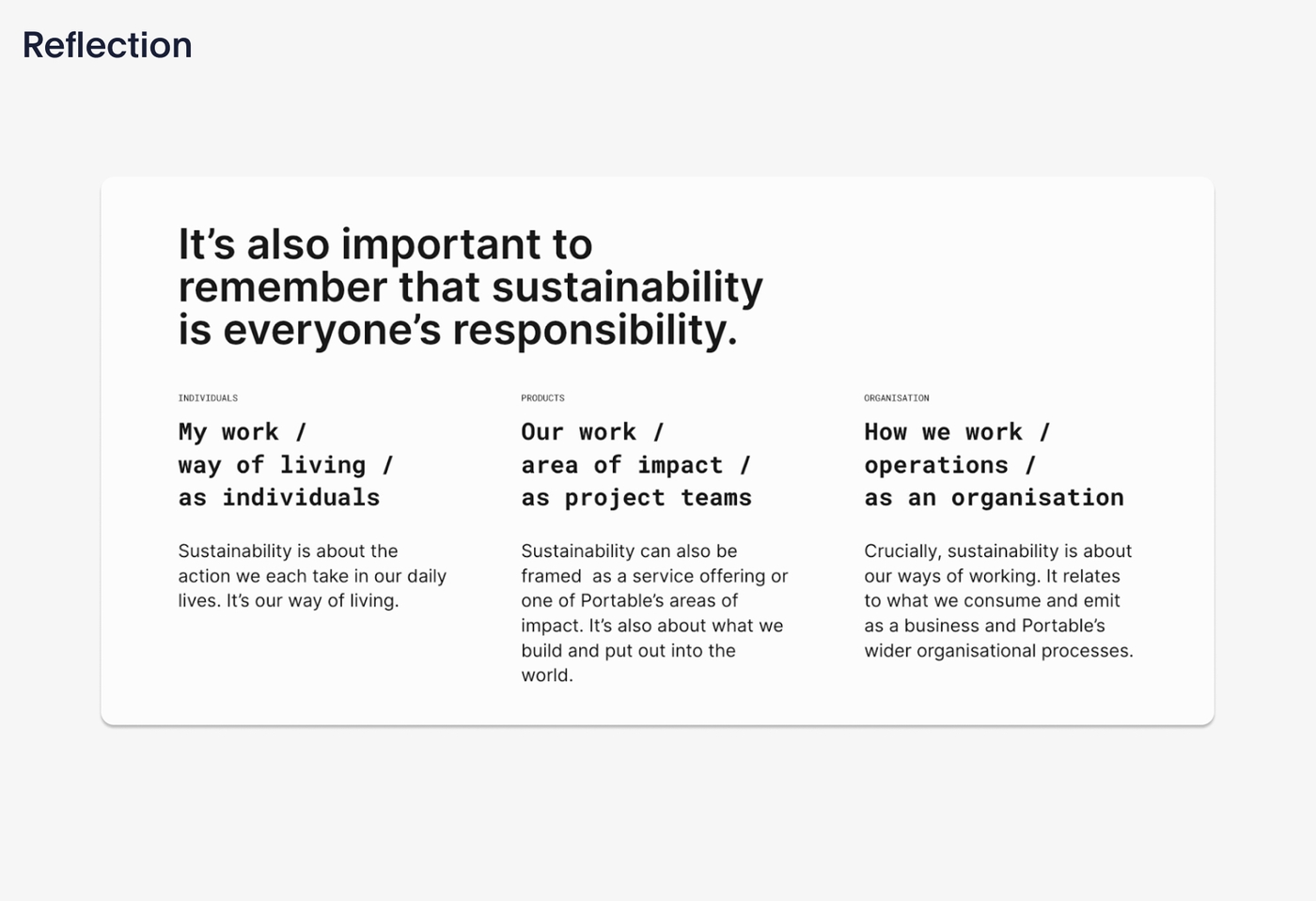
Overcoming communication challenges
Portable and The Business Pickle engaged a range of people in the design process. The senior leadership team came together to review each initiative and map them along a three-year timeline. They discussed and debated the feasibility of each initiative and some were taken off the board based on the organisation's capacity and values.
A challenge in this process was communication between the working group and the senior leadership team. The working group had a better understanding of the initiatives, their difficulty, and implications, while the senior leadership team had limited time to review them. This required breaking the process into multiple sessions to align everyone's understanding.
Creating a safe process involves relying on the company's values, such as caring about doing good work, trying new things, and giving good feedback for learning and growth. It was important to set expectations that there would be no right answers and that mistakes and course corrections are expected. Consistently seeking and incorporating feedback was found to help build trust among team members.
The goal is to ensure that the strategy is collectively owned and aligned with Portable’s values and objectives.
Initiatives that didn’t make it into the strategy
Through the process of deliberating on and refining the set of initiatives to include in the strategy, there were some that did not make it into the final strategy:
- Donating 5% of revenue to environmental causes: Portable may explore something like this in the future, as part of a wider donations policy for the business.
- Discounts for clients/projects that drive environmental impact: in Portable’s case, they see that there are more effective ways for them to drive impact (through other initiatives included in the strategy). While they may give discounts over time, they decided not to include this as a specific item within the strategy.
- Sending staff to global environmental conferences and rallies: the senior leadership team saw that the potential value and scale of the impact their team could make through these events would be lower than the investment and potential environmental impacts of international travel.
Outcomes
The aim of this project was to develop an environmental strategy that would:
- Generate positive environmental outcomes
- Stand the test of time
- Integrate with the wider business strategy for the next 3 years
- Have a strong evidence basis
- Contain practical and measurable initiatives
- Engage the wider staff team
- Inspire others in the industry to develop similar strategies
As the strategy is officially being introduced from July 2023, it is too early to say whether the initiatives will be successfully implemented and generate positive environmental outcomes. That said, the groundwork has been laid by taking a research-based approach, engaging the broader Portable team, and drawing on externally validated initiatives (for example, aiming for net zero in line with science-based targets and aligning with the B Corp certification framework).
The strategy is intentionally designed to be practical, tangible and achievable, grounded in the concrete realities of running a business.
We are committed to sharing our learnings through the process and welcomes external feedback!
Project Team
Harvey (previously The Business Pickle)
- Simon Smallchua
- Gillian Pereira
Portable
- Andrew Apostola
- Emily MacLoud
- Aishling Costello
- Deb Cupitt
- Ash Colcott